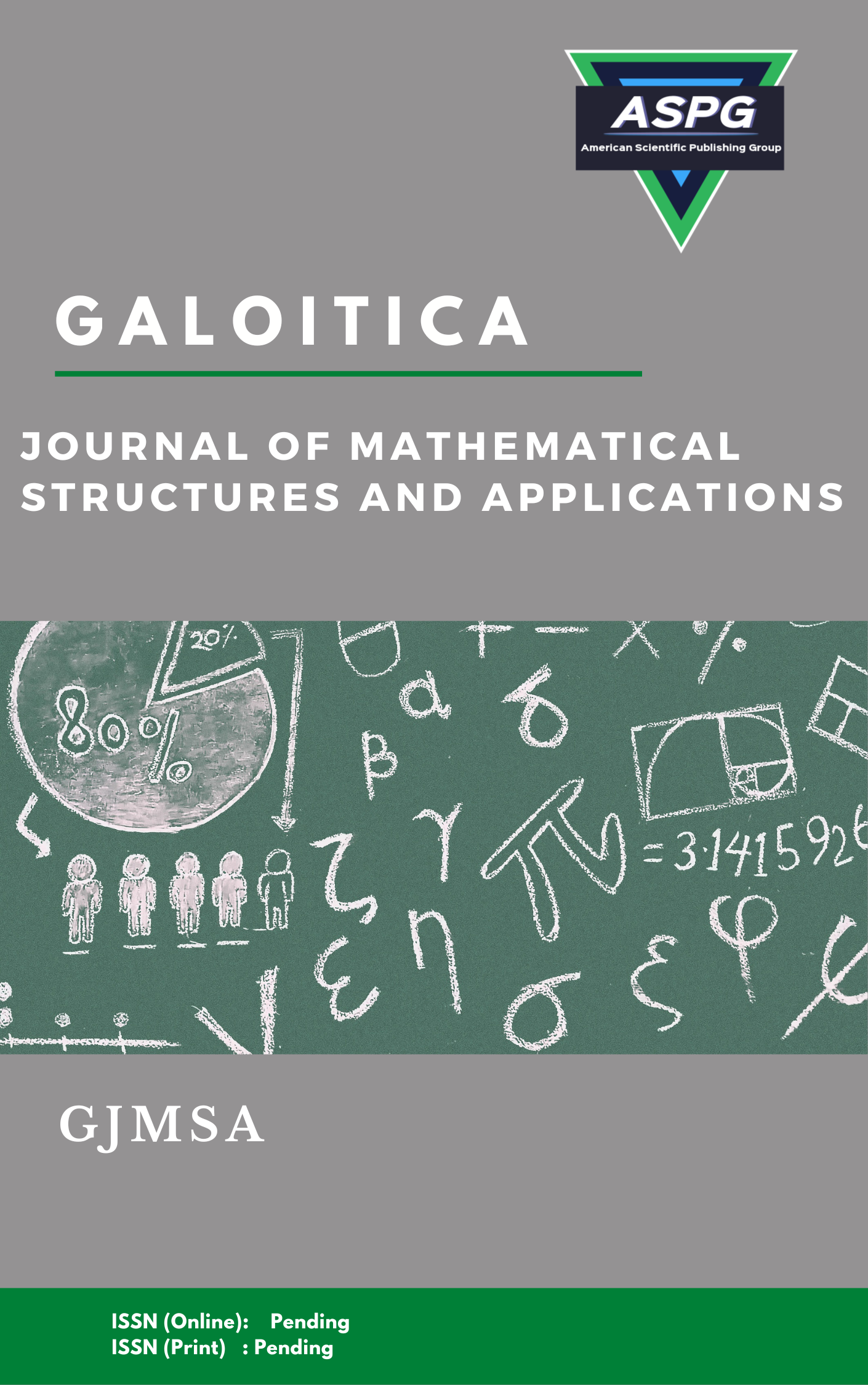

Volume 10 , Issue 2 , PP: 27-43, 2024 | Cite this article as | XML | Html | PDF | Full Length Article
Prem Kumar Singh 1 * , Naveen Surathu 2 , Ghattamaneni Surya Prakash 3
Doi: https://doi.org/10.54216/GJMSA.0100203
Recently Turiyam set and its algebra is introduced for dealing with the data containing human quantum cognition. This paper tries to extend the applications of Turiyam set while profile characterization at Social Network. To achieve this goal, a method is proposed for characterization of social network profiles in true regions (t), false region (f), Neutro region (i) and Liberal or Turiyam region (l), independently. The proposed method also provides implementation to understand the concept of Turiyam logic. In addition, many real life examples for data with Turiyam attributes is given with its four way characterization.
Knowledge representation , , multi-valued logic , Quaternion , Turiyam sets , Unknown.
[1] Adar, E., & Re, L. A. (2007). Managing Uncertainty in Social Networks. IEEE Transactions on Knowledge and Data Engineering, 19(2), 200-219.
[2] B. Sinclair-Desgagne (2023) Mining for Unknown Unknowns, Available at SSRN 4426652, EPTCS 379, pp. 507-517
[3] Deo, N. (2017). Graph theory with applications to engineering and computer science. Courier Dover Publications.
[4] Wang, X., Lu, W., Ester, M., Wang, C., & Chen, C. (2016). Social recommendation with strong and weak ties. In : Proceedings of the 25th ACM international on conference on information and knowledge management (pp. 5-14).
[5] Veličković, P. (2023). Everything is connected: Graph neural networks. Current Opinion in Structural Biology, 79, 102538.
[6] Abulaish, M., Zainuddin, H., & Abu Seman, A. H. (2012). Toward Understanding Friendship in Online Social Networks. International Journal of Information Technology and Computer Science, 4(1), 1-10.
[7] Singh, P. K. (2023a). Data with Turiyam Set for Fourth Dimension Quantum Information Processing. Journal of Applied Mathematics and Physics, 9(7), 1821-1828.
[8] Ganati, G.A., Repalle, V.N.S.R. &Ashebo, M.A. (2023a) Social network analysis by Turiyam graphs. BMC Res Notes 16, 170 (2023).
[9] Ganati, G. A., Repalle, V. R., Ashebo, M. A., & Amini, M. (2023b). Turiyam Graphs and its Applications. Information Sciences Letters, 12(6), 2423-2434.
[10] X. Deng and C. H. Papadimitriou (1990) Exploring an unknown graph. In: Proceedings of 31st Annual Symposium on Foundations of Computer Science, St. Louis, MO, USA, 1990, Vol. 1, pp. 355-361
[11] Naz, S., Rashmanlou, H., & Malik, M. A. (2017). Operations on single valued neutrosophic graphs with application. Journal of Intelligent & Fuzzy Systems, 32(3), 2137-2151.
[12] Koczy LT, Jan N, Mahmood T, Ullah K (2020) Analysis of Social Networks and Wi-Fi Networks by Using Concept of Picture Fuzzy Graphs. Soft Computing. Vol. 24, pp. 16551–63.
[13] Singh, P. K. (2021). Fourth Dimension Data Representation and Its Analysis Using Turiyam Context. Journal of Computer and Communications, 9(6), 222-229.
[14] P. K. Singh (2023b) Turiyam Set and its Mathematical Distinction from Other Sets. Galoitica: Journal of Mathematical Structures and Applications, Vol. 8, Issue 1, pp. 08-19.
[15] Singh PK. (2022a) Four-Way Turiyam Set-Based Human Quantum Cognition Analysis. Journal of Artificial Intelligence and Technology. Vol. 2, Issue 4, pp. 144–51.
[16] S. (1885) Four-Dimensional Space, Nature, Vol. 31, pp. 481.
[17] Dunn, J. M. (2019). Two, Three, Four, Infinity: The Path to the Four-Valued Logic and Beyond. In: H. Omori & H. Wansing (Eds.), New Essays on Belnap-Dunn Logic (pp. 77-118). Springer.
[18] Belnap J. N. (1975a) How Computers Should Think. pages 30 to 56 in Contemporary Aspects of Philosophy, Gilbert Ryle editor, Oriel Press ISBN 0-85362-161-6
[19] Belnap J. N. (1975b) A useful four-valued logic. In : J. Michael Dunn and George Epstein, editors, Proceedings of the Fifth International Symposium on Multiple-Valued Logic, Modern Uses of Multiple-Valued Logic. Indiana University, D. Reidel Publishing Company, pp 8-37.
[20] Font J. M. (1997) Belnap's Four-Valued Logic and De Morgan Lattices. In: Logic Journal of the IGPL, Vol. 5, no. 3, pp. 1-29.
[21] Singh PK. (2022b) Quaternion Set for Dealing Fluctuation in Quantum Turiyam Cognition. Journal of Neutrosophic Fuzzy Systems (JNFS), Vol. 4, Issue 02, pp. 57–64.
[22] Singh, P. K. (2023c). Mathematical Concept Exploration Using Turiyam Cognition. Galoitica: Journal of Mathematical Structures and Applications, Vol. 9, Issue 1, pp. 08-22.
[23] Irmak E., and Kurtuldu, Ö. (2015) Concept of 4th Dimension for Databases. In: Proceedings of 2015 IEEE 14th International Conference on Machine Learning and Applications (ICMLA), pp. 1159-1162.
[24] Basher, A. A., Ahmad, K. D., & Ali, R. (2022). An Introduction to the Symbolic Turiyam Groups and AH-Substructures. Journal of Neutrosophic and Fuzzy Systems, Vol. 3, Issue 02, pp. 43-52.
[25] Ani, A., Mashadi, M., &Gemawati, S. (2023). Invers Moore-Penrose pada Matriks Turiyam Simbolik Real. Jambura Journal of Mathematics, Vol. 5, Issue 1, pp. 95-114.
[26] Said, B., Lathamaheswari, M., Singh, P. K., Ouallane, A. A., Bakhouyi, A., Bakali, A., ... &Deivanayagampillai, N. (2022). An Intelligent Traffic Control System Using Neutrosophic Sets, Rough sets, Graph Theory, Fuzzy sets and its Extended Approach: A Literature Review. Neutrosophic Sets Syst, Vol. 50, pp. 10-26.
[27] M. S. Silva (2022) Latest Advances on AI and Robotics Applications, Journal of Artificial Intelligence and Technology, Vol. 2, Issue 4. pp. 131.
[28] U. Rivieccio (2008) Neutrosophic logics: prospects and problems. Fuzzy Sets Syst, Vol. 159, Issue 14, pp. 1860–1868.
[29] Han, M., Yan, M., Li, J., Ji, S., & Li, Y. (2014). Neighborhood-based Uncertainty Generation in Social Networks. Journal of Combinatorial Optimization, Vol. 28, Issue 3, pp. 561-576.
[30] Kapoor, P., Singh, P. K., & Cherukuri, A. K. (2020). Crime data set analysis using formal concept analysis (fca): A survey. Advances in Data Sciences, Security and Applications: Proceedings of ICDSSA 2019, pp. 15-31.
[31] Dai, S. (2023). Quaternionic Fuzzy Sets. Axioms, 12(5), 490.